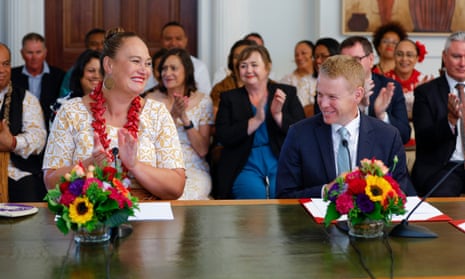New Zealand has reached gender equity in its government cabinet for the first time in its history.
The country had elected its most diverse parliament ever under former prime minister Jacinda Ardern in 2020, significantly boosting numbers of female, Māori and LBGTQ+ members. Now, it has reached gender parity at the decision-making table of cabinet, the body of senior ministers responsible for most important policy, legislative and spending decisions.
Prime minister Chris Hipkins announced on Monday afternoon that the latest cabinet reshuffle would see MP Willow-Jean Prime, minister for conservation, enter cabinet, meaning a 50/50 split of men and women.
“It means that we’re more closely representing the population,” Hipkins said. “I think it’s a good milestone to achieve. We achieved 50/50 representation in parliament in this parliamentary term, I think that’s a very welcome thing, and now we have that around the Cabinet table as well.”
Hipkins said that including ministers outside cabinet, there were now more women in New Zealand’s executive than there were men.
The 2020 general election saw a highly diverse executive come to power. About 10% of the members of New Zealand’s 2020-elected parliament identify as LGBTQ+.
This includes prominent leaders such as finance minister Grant Robertson. At election time, the 120-seat house included 25 Māori MPs – giving more than 20% representation in the house, alongside 9% Pasifika, and 9% MPs of other ethnicities, including MPs of Chinese, Eritrean, Indian, Iranian, Korean, Maldivian, Mexican and Sri Lankan descent.
Prime, the MP for Northland, also holds portfolios as the minister for youth, and associate minister for health and for arts and culture. Hipkins said that while he was pleased to see gender parity, it had not been a decisive factor in her selection. “I’m confident that she will be a very active contributor around the cabinet table,” he said.
